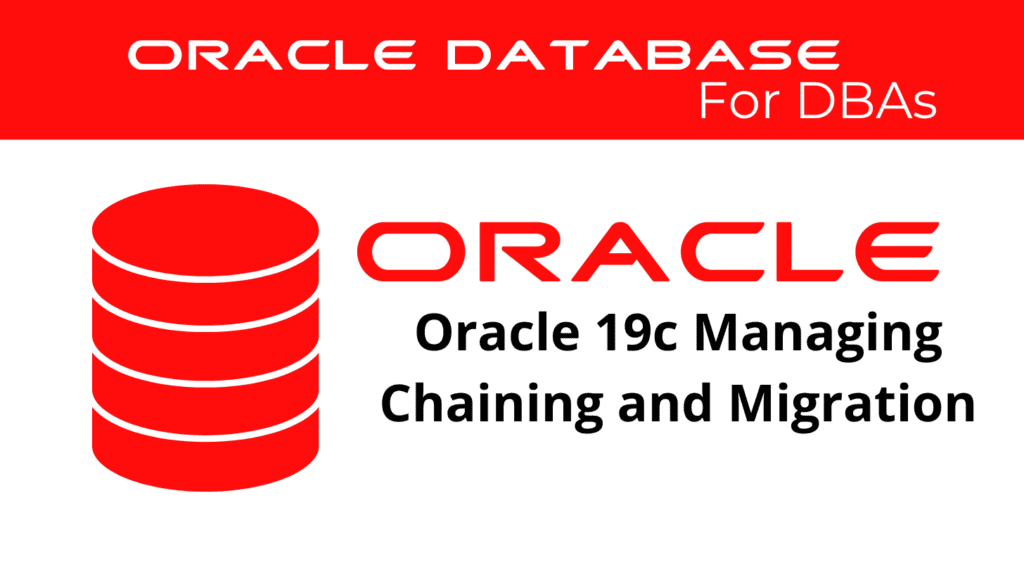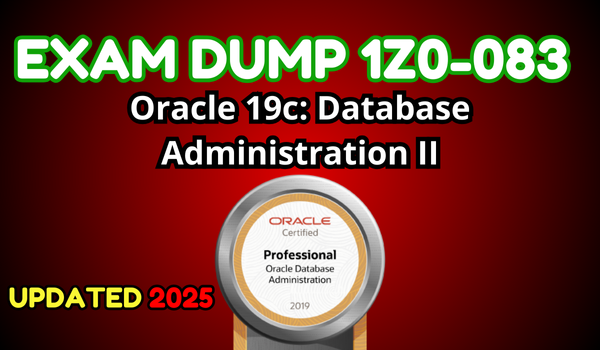
In Oracle 19c, managing chaining and handle migration of rows is critical for optimal database performance. This blog explores various techniques and strategies for effectively handling these issues, ensuring efficient storage and retrieval of data.
Understanding Row Chaining
Row Chaining occurs when a row is too large to fit into a single database block, causing it to be split across multiple blocks. This situation can lead to increased I/O operations as the database must access multiple blocks to retrieve the row.
To illustrate, consider a scenario where the default block size is 8KB. If a row exceeds this size, it will be divided into smaller chunks stored in different blocks. This fragmentation can significantly degrade performance due to the additional I/O overhead.
Manage chaining – When a table is created and populated with large rows, you might encounter row chaining. For example, create a table with the following command:
CREATE TABLE dba_gen_big (
id NUMBER,
description CLOB
);
Populate the table with large data to demonstrate chaining:
INSERT INTO dba_gen_big VALUES (1, RPAD('A', 9000, 'A'));
INSERT INTO dba_gen_big VALUES (2, RPAD('B', 9000, 'B'));
Analyze the table to refresh statistics:
ANALYZE TABLE dba_gen_big COMPUTE STATISTICS;
Check for chained rows:
SELECT table_name, chain_cnt
FROM dba_tables
WHERE table_name = 'DBA_GEN_BIG';
Techniques to Manage Chaining
Analyze and Identify Chained Rows: Use the ANALYZE command to identify chained rows in a table. This step is crucial for diagnosing performance issues related to row chaining. Identifying these rows allows for targeted interventions to improve performance.
Reorganize Tables: Moving tables to tablespaces with larger block sizes can reduce the occurrence of row chaining. Use the ALTER TABLE command to move tables to a new tablespace and then rebuild indexes to maintain data integrity. For example:
CREATE TABLESPACE dbagen DATAFILE 'dbagen01.dbf' SIZE 50M BLOCKSIZE 16K;
ALTER TABLE dba_gen_big MOVE TABLESPACE dbagen;
ALTER INDEX dba_gen_big_idx REBUILD;
Increase PCTFREE: Adjusting the PCTFREE parameter allows more space for rows to grow within a block, thereby reducing the likelihood of chaining. For instance:
ALTER TABLE dba_gen_big PCTFREE 30;
Manage chaining – Regular Maintenance: Regularly monitor and maintain tablespaces to ensure optimal performance. This includes reorganizing fragmented tables and adjusting storage parameters as needed. Consistent maintenance prevents issues before they become significant problems.
📢 You might also like: Oracle 19c Configuring Index and Table Performance Options (Category: Performance Management and Tuning)
Understanding Row Migration
Handle migration – Row Migration happens when an update to a row causes it to no longer fit in its original block. The entire row is moved to a new block, leaving a forwarding address in the original location. This process can also lead to increased I/O operations and degraded performance.
Similar to row chaining, row migration requires careful management to minimize its impact on database performance. For example:
UPDATE dba_gen_big
SET description = RPAD('C', 10000, 'C')
WHERE id = 1;
This update may cause row migration if the original block cannot accommodate the new row size.
Manage Chaining – Techniques to Handle Migration
Identify and Address Migrated Rows: Use the ANALYZE command and query the V$SYSSTAT view to identify migrated rows. Understanding the extent of row migration is the first step in addressing it. For example:
ANALYZE TABLE dba_gen_big LIST CHAINED ROWS INTO chained_rows;
SELECT *
FROM chained_rows;
Increase PCTFREE: As with row chaining, increasing the PCTFREE parameter can provide more room for rows to grow within their original blocks, reducing the need for migration. This adjustment can be particularly effective in environments with frequent updates.
Reorganize Tables: Regularly reorganize tables to compact data and eliminate fragmentation. The ALTER TABLE ... MOVE command can be used to relocate data and improve storage efficiency. For example:
ALTER TABLE dba_gen_big MOVE;
Regular Index Rebuilds: After significant data modifications, rebuild indexes to ensure they remain efficient and effective in accessing data. For instance:
ALTER INDEX dba_gen_big_idx REBUILD;
Conclusion
Managing chaining and migration in Oracle 19c is essential for maintaining database performance and efficiency. By understanding these concepts and implementing the techniques discussed, you can significantly reduce the impact of row chaining and migration on your database operations. Regular monitoring, maintenance, and optimization of storage parameters are key to achieving optimal performance. Adopting these strategies ensures that your database remains responsive and efficient, even as data volumes grow.
See more on Oracle’s website!
Be Oracle Performance Management and Tuning Certified Professional, this world is full of opportunities for qualified DBAs!





